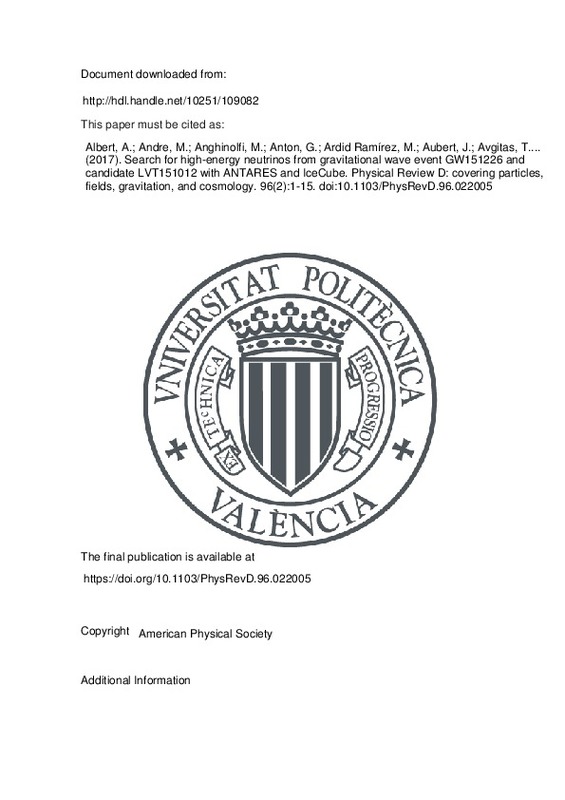JavaScript is disabled for your browser. Some features of this site may not work without it.
Buscar en RiuNet
Listar
Mi cuenta
Estadísticas
Ayuda RiuNet
Admin. UPV
Search for high-energy neutrinos from gravitational wave event GW151226 and candidate LVT151012 with ANTARES and IceCube
Mostrar el registro completo del ítem
Albert, A.; Andre, M.; Anghinolfi, M.; Anton, G.; Ardid Ramírez, M.; Aubert, J.; Avgitas, T.... (2017). Search for high-energy neutrinos from gravitational wave event GW151226 and candidate LVT151012 with ANTARES and IceCube. Physical Review D: covering particles, fields, gravitation, and cosmology. 96(2):1-15. https://doi.org/10.1103/PhysRevD.96.022005
Por favor, use este identificador para citar o enlazar este ítem: http://hdl.handle.net/10251/109082
Ficheros en el ítem
Metadatos del ítem
| Título: | Search for high-energy neutrinos from gravitational wave event GW151226 and candidate LVT151012 with ANTARES and IceCube | |
| Autor: | Albert, A. Andre, M. Anghinolfi, M. Anton, G. Aubert, J.J. Avgitas, T. Baret, B. Barrios-Marti, J. Basa, S. Bertin, V. Biagi, S. Felis-Enguix, Iván Saldaña-Coscollar, María | |
| Entidad UPV: |
|
|
| Fecha difusión: |
|
|
| Resumen: |
[EN] The Advanced LIGO observatories detected gravitational waves from two binary black hole mergers during their first observation run (O1). We present a high-energy neutrino follow-up search for the second gravitational ...[+]
|
|
| Palabras clave: |
|
|
| Derechos de uso: | Reserva de todos los derechos | |
| Fuente: |
|
|
| DOI: |
|
|
| Editorial: |
|
|
| Versión del editor: | https://doi.org/10.1103/PhysRevD.96.022005 | |
| Código del Proyecto: |
|
|
| Agradecimientos: |
Additional support for Advanced LIGO was provided by the Australian Research Council. The authors gratefully acknowledge the Italian Istituto Nazionale di Fisica Nucleare (INFN), the French Centre National de la Recherche ...[+]
|
|
| Tipo: |
|







![[Cerrado]](/themes/UPV/images/candado.png)


